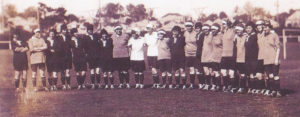
Women started playing football in Queensland in 1921.
Despite many challenges, women have continued to play football all over the state.
This website chronicles the women’s game from the 1920s till now and tells the stories of women who have made the game what it is today.
In June of 1913, the Daily Standard described a ladies versus gentlemen match in Gatton. This match is the earliest confirmed football game we know of where women played.
Then in 1921, women’s clubs started to form in Toowoomba and Brisbane. Players in Brisbane used an aluminium painted ball so they could practice at night.
The first public game of football played by women in Australia took place at the Brisbane Cricket Ground, The Gabba, on 24 September 1921.
10,000 people attended the match which was was well-received by the crowd. The Queensland Times described, ‘the skilful treatment of the game by these young ladies’, and noted that ‘the girls showed remarkable stamina’, and ‘evidence of keen training’. Only a few weeks later a headline match in Ipswich drew 3000 on its own.
By the end of 1921, the English Football Association’s views on women’s football were well-known in the Australian British Association Football community. J.W. Kendall, Chair of the Queensland Football Association, only begrudgingly entertained the idea of women playing. In early February 1922, the British Association Interstate Conference in Melbourne elected to follow their EFA counterparts and ban women.
While some women continued to play despite the ban, others were reluctant as a result of their fear of public opinion.
During the 1930s many women were stuck on the sidelines. For example in Mackay, there appeared to be no opportunities for women to play football. But that did not stop women being passionate about the game. The Mackay Daily Mercury reported at the time that women supported the local teams and participated in “good-natured barracking heard on all sides.” However, in Ipswich, women were creating opportunities to play. Weekly ‘ladies’ soccer’ meetings were advertised in local newspapers in 1932-33. Teams played in Booval and Bundamba.
In 1933, an article in Brisbane Telegraph suggested an intercity soccer competition. The all-male committee of the West Moreton British Football Association felt that the games would provide excellent curtain raisers for the men’s competition. However, their conservative Brisbane counterparts did not agree. Those Brisbane residents who petitioned for intercity competition were told that, ‘Football was not a suitable past-time for women’.
By the 1940s, women in more regional areas of Queensland were beginning to play. In Rockhampton, during the late 1940s, a match was played in aid of the Rockhampton Ambulance at Lakes Creek Ground in October 1947 between a ladies team and a minor boy’s team.
A week or so after the match between the minor boys team and ladies team, another reportedly exciting match took place at a Nerimbera Soccer Club picnic. Over 200 people attended and this time the match was between two ladies teams.
By the 1950s, a Rockhampton team had established itself. They often played the nearby ladies team at Mt Morgan.
Read a more in depth history of women’s football by region below.
During the 1960s and 1970s women’s soccer re-established itself in Queensland. For example, in Brisbane, women established multiple teams and a competition during the 1960s. We also have evidence that a competition was established in Mt Isa around the same time.
In the 1970s, a State Championship was established in Queensland. During this time many regional locations began to establish teams and compete in the State Championship. For example, in Rockhampton, women started establishing teams again during the mid 1970s and Mackay established its first teams and competitions around the same time.
In the 1980s, women’s football continued to expand. Leonie Young (nee Yow Yeh) became the first Indigenous woman to play for Queensland and later established Brisbane’s first Indigenous women’s football team. It is important to acknowledge here the significant barriers First Nations players face. Maynard (2011, 14 & 34) points out that “historically, Aboriginal players were largely ignored by the soccer authorities” and that racist and restrictive government policy of segregation meant that Aboriginal people were often cut off from sporting opportunities.
Queensland women also began to play on the world stage. In 1988, the national team (including Queensland players) played in the Women’s World Invitational Tournament in Taiwan.
During the early 2000s the popularity of women’s football continued to grow. For example, in 2008/09, the Brisbane Roar had their first season. During this season they achieved ‘the double’ – becoming the first W-League Premiers and then beating Canberra United (2-0) in the 2009 W-League Grand Final.
More recently the Matildas (our national team which includes several Queensland players) was ranked number 4 in the FIFA world rankings in 2017. With the next FIFA Women’s World Cup set to be hosted by Australia, Queensland women’s football is sure to continue growing.
Read a more in depth history of women’s football by region below.



We acknowledge the Traditional Custodians of the land on which the events presented in this digital history occurred and acknowledge that sovereignty was never ceded. We recognise Aboriginal and Torres Strait Islander peoples and their continuing connection to land and waterways as well as their rich history of sports and significant continuing contribution to football.